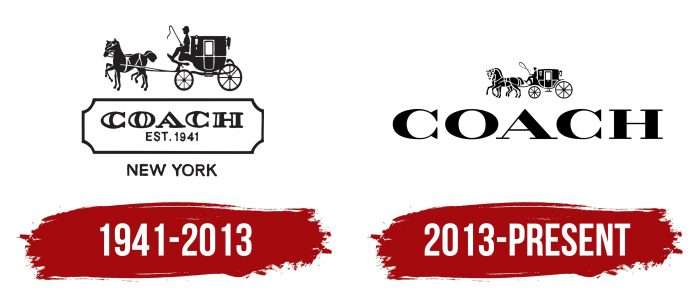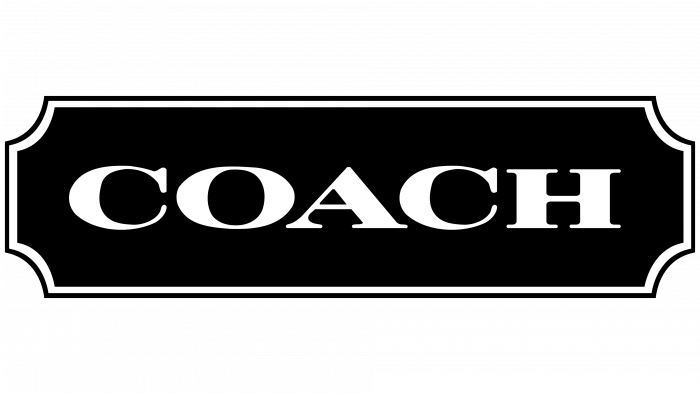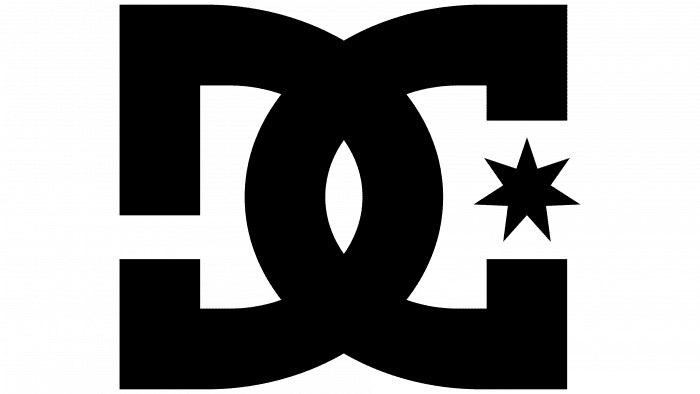The Coach logo speaks of accessories in an official, simple style with elements of elegance and luxury. The company’s products will add a “zest” to businesspeople’s image. The emblem shows that the products fit well in any color scheme.
Coach: Brand overview
Meaning and History
In 1941, a family of artisans teamed up to create handcrafted leather goods. The craftsmen named their mini-enterprise Manhattan Leather Bags and only dealt with wallets for a long period. Over time, they expanded the business because new leather processing methods allowed them to expand their range. The sales volumes grew rapidly; the products were distributed overseas. By the time the brand had a chain of its boutiques, it was already known under Coach.
Its logo has become famous worldwide, a testament to high quality and elitism. Bonnie Cashin developed the first version of the logo. She joined the company in 1961 and served as its Creative Director for a long time.
What is coach?
Coach is the name of a fashion brand of bags of all kinds, watches, shoes, jewelry, and ready-to-wear. It is owned by Tapestry, Inc., which previously had the same name. Now the luxury brand occupies a leading position in the production of various accessories and owns almost 990 stores worldwide. The year of its foundation is 1941; the location is New York.
1941 – 2013
As a result of the rebranding, the organization received the new name Coach and the associated logo. This is a well-known image of a carriage, coachman, and two harnessed horses ready to hit the road. One horse shifts impatiently from foot to foot, and the other stands still, waiting for the command. The image of the coachman also has a dynamic —he holds a whip in his hand.
The second element of the composition is a rectangular plaque with cut corners. The brand’s name is written on it, and the designers used a font similar to the stencil. The letters are half black, half white. On the same plate, but slightly below, is the year Coach was founded. It is presented in an abbreviated format: “EST. 1941 “.
The third part of the logo is the city’s name, where the workshop was previously based, and where the fashion concern is now located. Like the rest of the lettering, the designers have aligned the word combination “NEW YORK” in the center. The font is similar to a sans-serif typeface.
2013 – today
The Coach emblem evolved in 2013. Upon closer examination, it is noticeable that the shape of the carriage, the horses’ details, and the coachman’s look have changed. The whip no longer hangs down freely but bends in a loop, creating the effect of movement. However, the design remains the same: the graphic element is completely black and contains small splashes of white.
Below is the name of the trademark – this time without the year of foundation. It is written in one-color type with contrasting strokes and elongated serifs. The polygonal frame is gone, as is the mention of the city in which Coach is based. But the plate is on the second logo. Inside it is the company’s name, for which the designers have chosen a slightly different font. This is a modern interpretation of the old wordmark.
Coach: Interesting Facts
Coach, Inc., now under Tapestry, Inc., is a symbol of affordable luxury in fashion, known for its quality leather goods and stylish clothing. Since starting in a Manhattan loft in 1941, Coach has become a prominent global brand prized for its craftsmanship and design.
- Craftsmanship Foundation: Founded by six leather craftsmen, Coach has always prioritized making high-quality, functional leather items, a commitment that continues today.
- Leather Innovation: Coach made a name for itself with glove-tanned cowhide, which makes leather softer and more durable, a hallmark of its products.
- Pioneering Design: Bonnie Cashin, Coach’s first head designer in 1962, introduced iconic features like the turn-lock closure and created the distinct “Coach look” that merged style with practicality.
- Evolving Logo: Designed by Cashin and Carl Rosen, the Coach logo symbolizes the brand’s quality, American heritage, and style, undergoing slight changes over time.
- It was becoming Tapestry, Inc.: In 2017, Coach, Inc. became Tapestry, Inc., expanding to include other luxury brands like Kate Spade, New York, and Stuart Weitzman.
- Global Presence: Known for its American essence, Coach has successfully entered international markets, notably Japan, China, and Europe, gaining worldwide recognition.
- Creative Collaborations: Coach has teamed up with artists, designers, and celebrities for limited edition collections, bringing new life to its classic designs with innovative twists.
- Personalization Services: Coach offers customization, allowing customers to add a personal touch to their purchases, underscoring the brand’s focus on individual style and craftsmanship.
- Cultural Significance: Beyond fashion, Coach has made its mark in pop culture, with its products appearing in movies, TV shows, and celebrities, cementing its status as a style icon.
From its humble beginnings to becoming a global lifestyle brand, Coach’s story is a testament to its lasting commitment to quality, innovation, and a style that blends elegance with functionality, resonating with customers worldwide.
Font and Colors
Coach still uses the iconic classic emblem. A coachman, a carriage, and two horses are the most recognizable symbols of the brand, so no one is in a hurry to carry out a global redesign. The logo has proven itself well and has stood the test of time. Now, it adorns all the fashionable goods the New York manufacturer produced.
The old Coach font is similar to AZ Placid Regular or Ecuyer Dax, although the differences are noticeable. Long serifs unite them at the ends and a double color: dark contours are combined with the inner emptiness. In the new version, the inscription is completely black. The designers painted over the gaps and aligned the lines to make them look modern. The letterforms on the logo in the frame are unclear, and both “C” are missing the bottom serif.
The primary color remains black, and the secondary color is white. Such a seemingly simple combination symbolizes prestige, superiority, elitism, and a high level of the brand.
FAQ
What is the meaning of the Coach logo?
The logo symbolizes luxury, social status, and dignity. The classic, timeless design matches the brand’s reputation for fine leather goods and accessories.
The logo features a horse-drawn carriage known as a “coach,” directly referencing the brand’s name and origins. The horse and carriage signify travel, suggesting that product ownership is part of a lifestyle that strives for sophistication and increased social status.
The logo’s typography enhances its classic appeal. An elegant and discreet font complements the image of the carriage. The logo’s black-and-white color scheme emphasizes a sophisticated approach to luxury. The simplicity of the colors makes the carriage’s details stand out, making the logo easily recognizable and synonymous with high fashion.
Is Coach a luxury brand?
Yes, Coach is a luxury brand. Known as Coach New York, it is an American fashion house specializing in leather bags, luggage, accessories, and ready-to-wear. The company is known for its high-quality craftsmanship, exquisite designs, and premium materials.
The brand’s products include bags, suitcases, shoes, clothing, and accessories such as wallets, belts, and glasses. It maintains a presence in high-end retail outlets and operates flagship stores in major cities worldwide. These stores offer an exclusive shopping experience that reflects the brand’s upscale image. Collaborations with renowned designers and celebrities further strengthen the company’s position in the luxury goods market.
Is the C in Coach a horseshoe?
The “C” in the logo is shaped like a horseshoe, symbolizing its connection to equestrianism and traditional leather craftsmanship.
The horseshoe shape of the letter “C” serves several purposes:
- Equestrian connection
- Heritage and Craftsmanship
- Symbol of good luck and protection
- Brand recognition and personality
- Visual appeal and versatility
The horseshoe-shaped “C” in the logo emphasizes the brand’s connection to equestrian sports. This symbol reinforces the brand’s identity, emphasizing elegance, prestige, and reliability, and serves as a unique and recognizable visual branding element.
What is the symbol for Coach?
The luxury fashion house’s symbol is a carriage with a coachman and two horses. This iconic symbol represents the brand’s heritage and values, demonstrating sophistication, prestige, elegance, and luxury.
Images of horse-drawn carriages are rich in historical and cultural meaning:
- Symbol of high social status
- Sophistication and elegance
- Historical prestige
- Luxury and craftsmanship
- Ambitious lifestyle
- Timeless appeal
The symbol of a carriage with a coachman and two horses symbolizes high social status, sophistication, elegance, and luxury. It reflects the brand’s heritage of excellence and resonates with consumers who seek quality and a rich tradition of craftsmanship.
Do all Coach bags have the logo inside?
Yes, all original Coach bags have a logo tag inside. This tag contains the logo and serial number, which is important to verify the bag’s authenticity.
The logo tag inside the bag serves several important purposes:
- Authentication
- Brand identity
- Quality assurance
- Historical record
- Customer service
- Design integrity
This tag is critical for verifying authenticity, strengthening brand identity, ensuring quality, maintaining historical records, facilitating customer service, and maintaining design integrity.
Did Coach change their logo?
The brand updated its logo in 2013 as part of a comprehensive rebranding effort. The new logo is more elegant and sophisticated, reflecting a modern yet timeless look that matches the brand’s luxury image.
Several changes have been made:
- Clarification of the carriage and coachman
- Improvement of the horses
- Customizing the caption
- Balanced composition
- The modern yet timeless appeal
The logo update featured a more elegant design highlighting the coachman, carriage, and horses. The lettering was enlarged and converted to a serif font, creating a balanced and sophisticated logo.








